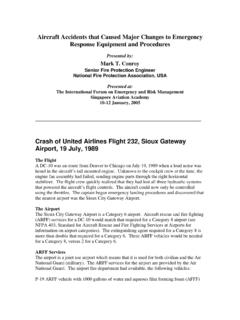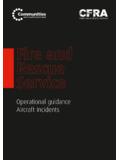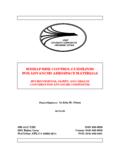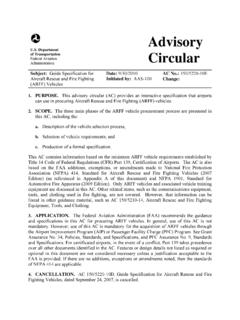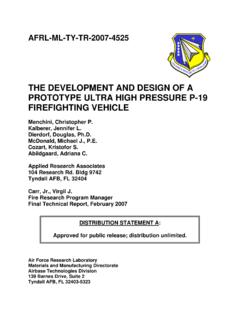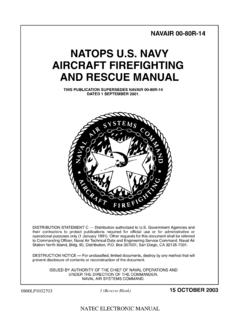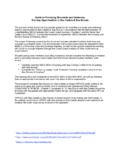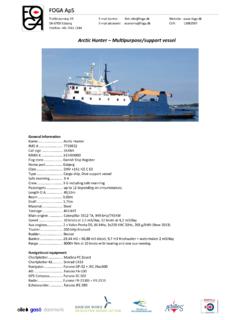Transcription of Designing a Water Rescue Plan for Airports
1 Designing a Water Rescue plan for Airports Abstract airport Emergency Services An airport Water Rescue plan is an integral and essential component in an emergency plan for Airports located in close proximity to Water bodies. Unlike tactical plans that attend to an aircraft accident on terra firma within the aerodrome, an aircraft mishap at sea often involves a greater degree of complexity and brings with it unique challenges and difficulties. This paper aims to draw reference from existing international standards, recommendations and guidelines in developing a set of principal considerations in the development of a Water Rescue plan for Airports .
2 These considerations are deliberately developed to provide airport operators with the flexibility to adjust and tweak their plans to better suit their operating environment. Designing a Water Rescue plan for Airports About the Author Mr Edwin Lim is Head of Planning in the airport Emergency Service (AES) division of Changi airport Group, Singapore. He oversees the AES. functions in operations, manpower and logistics planning, standards assurance, special projects as well as the planning, control and review of AES'. annual budget. Since January 2010, Mr Lim was appointed Singapore's representative in ICAO's Rescue and Fire-fighting Working Group which was responsible for the review and development of Standards and Recommended Practices.
3 He holds a Bachelor of Science (Hons) in Fire Safety and Management and a Master of Science in Air Safety Management under the CAAS Overseas (Operations) Scholarship in 2005. airport Emergency Services 01. Designing a Water Rescue plan for Airports Mr Edwin Lim Changi airport Group, Singapore INTRODUCTION. All pictures speak a thousand words. However, not many can boast of being able to tell a story on their own. Just like the Tank Man' who was photographed stopping the advance of a column of tanks during the 1989 Tiananmen Incident, and the soldiers planting the American flag on the Japanese island of Iwo Jima during World War II.
4 On 1945, the image below is certainly an enduring one which will be firmly imprinted on the minds of many for years to come. Hailed as the Miracle on Hudson' by major news broadcasters, emergency agencies, pilots and even politicians alike, all 155 persons onboard the US Airways Airbus A320 were pulled to safety as the plane ditched in the frigid Hudson river on 15 January 2009. Figure 1: Passengers waiting for Rescue on the wings of US Airways Flight 1549. Source: Reuters airport Emergency Services 02 Designing a Water Rescue plan for Airports THE HUDSON MIRACLE. It is not difficult to understand why the accident was considered a miracle, and no surprise when the pilot of the aircraft, Captain Chesley Sullenberger, received universal tributes after successfully manoeuvring his crowded jetliner over New York City and into the Hudson river with an impact that was described as not a whole lot more than a rear-end collision'.
5 1. History has proven that aircraft accidents at sea rarely end with such fortunate outcomes. The Hudson crash took place almost exactly 27 years after an Air Florida plane crashed into the Potomac River and sank shortly after taking off from Washington National airport , US. Seventy-four out of a total of 79. passengers onboard perished together with four fatalities on the ground. In the past few years, several unfortunate accidents bore testament to the low survivability rates of aircrashes into Water bodies. On 25 January 2010, an Ethiopian Airlines Boeing 737 plane crashed into the Mediterranean Sea in stormy weather, two miles west of Lebanon.
6 None of the 90 persons onboard survived. On 30 June 2009, a Yemenia Airway Airbus A310 crashed into the Indian Ocean, 10 miles off the coast of the Comoros island while attempting a second approach to land. Out of the 153 persons onboard, only a 14-year-old girl survived. Just four weeks earlier on 1 June 2009, an Air France Airbus A330 jetliner went down over the Atlantic Ocean en route to Charles de Gaulle. All 228. persons onboard perished. Figure 2: Salvage operations of Air France Flight 447. Source: Associated Press The accidents listed above all occurred in very different circumstances which had no doubt affected the outcomes to varying degrees.
7 Therefore, it would also not be fair to assume that the tragic endings of these accidents were caused by an absence of certain factors which contributed to the Miracle on Hudson'. 1 Personal account from a passenger on board US Airways Flight 1549. Journal of Aviation Management 2010. 03. What factors could the Miracle on Hudson' be attributed to? Was it the heroic actions of Captain Sullenberger? Was it divine intervention, or was it sheer luck? One thing we can be sure of is that the outcome would have been drastically different if an effective Water Rescue plan had not been put in place. INTERNATIONAL REQUIREMENTS AND GUIDELINES.
8 Annex 14 (Aerodromes) to the Convention on International Civil Aviation states that: [t]he (aerodrome emergency) plan shall include the ready availability of and coordination with appropriate specialist Rescue services to be able to respond to emergencies where an aerodrome is located close to Water and/or swampy areas and where a significant portion of approach or departure operations takes place over these areas.. Similarly, the Federal Aviation Administration (FAA), US, mandates that: [e]ach (aerodrome) certificate holder shall develop and maintain an airport emergency plan designed to minimise the possibility and extent of personal injury and property damage on the airport in an emergency.
9 The FAA Code of Federal Regulations Part also states that the aerodrome emergency plan must include procedures and guidance for prompt response to Water Rescue situations.. Both ICAO and FAA have published comprehensive guidance materials to aid aerodrome operators in the promulgation of Water Rescue plans. These can be found in the ICAO airport Services Manual Part 1. ( Rescue and Fire-fighting) and Part 7 ( airport Emergency Planning), as well as the FAA Advisory Circular (AC) No: 150/5210-13B. Airports differ and will naturally operate under vastly dissimilar environments and conditions. The objective is to create conditions in which survival is possible in the event of an accident, and from which the mission can succeed.
10 It is therefore crucial for crisis managers to adapt these guidelines into a feasible, relevant and effective plan not just for the aerodrome operator, but for other mutual aid agencies who have a part to play in the successful mitigation of any air disaster. PRINCIPAL CONSIDERATION 1 UNIQUE CONDITIONS DURING AN AIRCRASH INTO Water . Any Water Rescue plan must take into account the unique and harsh circumstances survivors are subjected to during an aircraft accident in Water . The success of the Rescue mission will therefore be greatly influenced by the plan 's ability to address these concerns.
